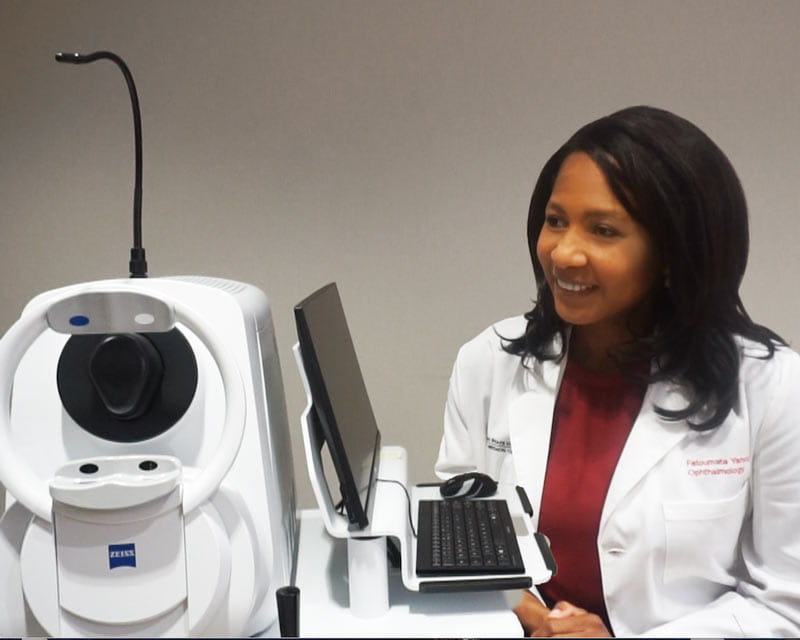
Swept-source OCT angiography reveals exquisite details of ocular structures
 By studying the genetics of glaucoma and risk factors, Raymond Gao, PhD, focuses on predicting which patients have significant intraocular pressure fluctuations under treatment. There is growing evidence that such fluctuations contribute to glaucoma progression.
By studying the genetics of glaucoma and risk factors, Raymond Gao, PhD, focuses on predicting which patients have significant intraocular pressure fluctuations under treatment. There is growing evidence that such fluctuations contribute to glaucoma progression.
Dr. Gao, an associate professor in the departments of Ophthalmology & Visual Science and Biomedical Informatics, and the Division of Human Genetics at The Ohio State University, hopes his research will improve outcomes by shifting “trial-and-error” treatments to personalized, precision treatments based on the individual’s genetic risk profile.
“I want to help clinicians improve treatment outcomes by taking into account individual variability in genes, environment and lifestyle for each person,” Dr. Gao, an associate professor at the College of Medicine, says.
“I look for genetic markers associated with glaucoma and its clinical risk factors that are quantitative traits, such as intraocular pressure (IOP), cup-to-disc ratio and central corneal thickness, and drug responses. These genetic markers enhance our understanding of the genetic architecture of glaucoma and suggest new detection and therapeutic avenues.”
Glaucoma affects more than 70 million people worldwide and is projected to increase to 111 million by 2040. This eye disease remains a leading cause of irreversible blindness. Dr. Gao uses genetic data and machine learning to predict disease onset. About 50% of people who have glaucoma don’t know they have the disease because it doesn’t show typical symptoms for years.
“Since there’s no cure for glaucoma, early detection is crucial to preserve vision,” he notes. “Lowering IOP is the proven therapeutic intervention that helps prevent development or progression of glaucoma. I find data that guides and helps build models that better predict disease onset before it causes ocular damage in patients.”
As a statistical geneticist, Dr. Gao says he wants to help reduce the burden of eye disease and blindness.
He says learning more about the many factors that contribute to glaucoma and which genetic loci are responsible for certain disease processes could help clinicians make better diagnoses and tailor treatment to individual genomic differences.
His current research focuses on identifying which patients may be more likely to have significant pressure fluctuations, or who may be more likely to respond to a certain treatment.
“There is no cure for glaucoma at this time,” Dr. Gao says. “I hope that, through my research, I can make some contributions to and advance the application of precision medicine in this challenging eye disease.”
Dr. Gao finds great personal satisfaction in pursuing knowledge that has never been reported and building models that can help predict the onset and progression of disease. His work is funded through the National Institutes of Health.
“When I think about researchers who work on similar topics or in similar fields, I feel like part of a larger, synergistic community,” he says. “We’re all utilizing our unique gifts and expertise to achieve common and much greater goals.”
In an article published in 2019 (Gao XR, Huang H, Kim H. Polygenic risk score is associated with intraocular pressure and improves glaucoma prediction in the UK Biobank cohort. Translational Vision Science & Technology 2019), Dr. Gao and his colleagues described their assessment of polygenic risk scores (PRSs) in relation to IOP and glaucoma, using a cohort of half a million individuals.
PRSs examine the cumulative effect of genetic variants on a disease or trait by aggregating the individual genetic effects into a single measure. Using genetic information to help predict onset of disease has been applied to breast cancer, type 2 diabetes and coronary artery disease. Dr. Gao says he’s used a similar approach for studying glaucoma.
“We observed significant association between the risk score and intraocular pressure, which improves the prediction of glaucoma,” he says. “In the study cohort, subjects in the top quintile of the IOP PRS were greater than six times more likely to have glaucoma than those in the bottom category.”
He also notes that he believes that polygenic risk scores are a promising tool for the early screening and identification of disease in asymptomatic individuals at risk for disease development.
“Early detection gives susceptible individuals the opportunity for earlier medical intervention.”
Dr. Gao is a leader of ocular genomics research for multiple National Eye Institute-funded projects on glaucoma genetics, steroid-induced ocular hypertension, and ocular biostatistics and genetic analysis. He’s published widely on a variety of topics in vision research, statistical genomics and genetic epidemiology.